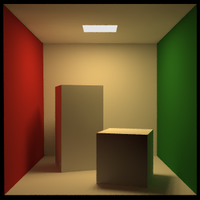Cornell Box
|
|
- For the (unrelated) "Cornell's box" sculptures, see Joseph Cornell

The Cornell Box is a test aimed at determining the accuracy of rendering software by comparing the rendered scene with an actual photograph of the same scene. It was created by the Cornell University Program of Computer Graphics for a paper published in 1984.
A physical model of the box is created and photographed with a CCD camera. The exact settings are then measured from the scene: emission spectrum of the light source, reflectance spectra of all the surfaces, exact position and size of all objects, walls, light source and camera.
The same scene is then reproduced in the renderer, and the output file is compared with the photography.
The basic environment consists of:
- One light source in the center of a white ceiling
- A blue right wall
- A red left wall
- A white back wall
- A white floor
Objects are often placed inside the box. The first objects placed inside the environment were two white boxes. Another common version first used to test photon mapping includes two spheres: one with a perfect mirror surface and one made of glass.
The physical properties of the box are designed to show diffuse interreflection. For example, some light should reflect off the red and green walls and bounce onto the white walls, so parts of the white walls should appear slightly red or green.
Today, the Cornell Box is often used to show off renderers in a similar way as the Stanford Bunny, the Utah teapot, and Lenna: computer scientists often use the scene just for its visual properties without comparing it to test data from a physical model.
External links
- The Cornell Box website (http://www.graphics.cornell.edu/online/box/)
